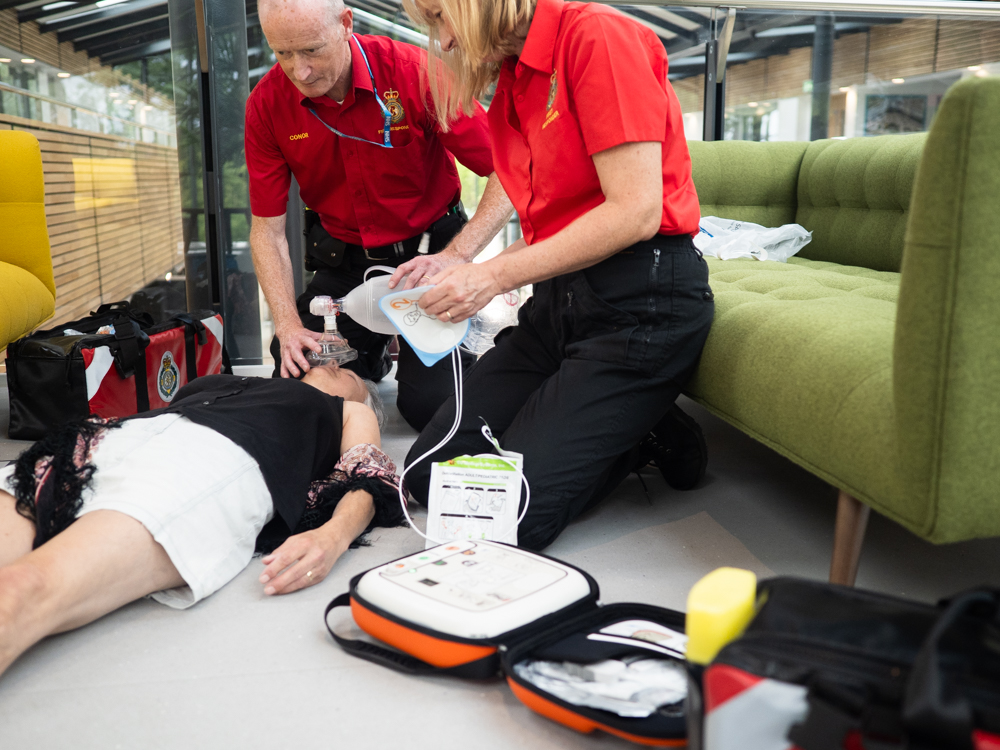
Defibrillators in the Community
Immediate CPR and using a Defibrillator can significantly improve survival rates of Cardiac Arrests.

Background
In the UK fewer than 10% of all the people in whom a resuscitation attempt is made outside hospital survive. Performing immediate CPR and using a Defibrillator can significantly improve these figures. Woking Community Responders are proactively involved in maintaining a number of AED’s (Automated External Defibrillators) in the local community. This includes keeping the pads and batteries in working order, checking that people in the locations of the defibrillators have adequate knowledge should they need to use them and providing training as required. You can register an AED with The Circuit – the national defibrillator network. This then works with the GoodSam App which alerts you to the location of many of the devices if you need one in an emergency.
Frequently Asked Questions
What is Sudden Cardiac Arrest (SCA)?
Sudden Cardiac Arrest (SCA) is a condition that causes the heart to stop pumping blood properly because of a fault. This can be caused by many things but the resulting lack of blood circulation starves the brain and vital organs of oxygen; unconsciousness is rapid and death will follow in minutes if emergency treatment is not started immediately.
What is an AED?
An AED (Automated External Defibrillator) is a small, portable device that analyses a person’s heart rhythm and can recognise if they have certain irregular heart rhythms such as fibrillation. Fibrillation of the heart is the rapid, irregular and unsynchronised contraction of the muscle fibres which can lead to death within minutes. An AED will automatically deliver a therapeutic dose of electrical energy to the person’s heart. This can stop the fibrillation and allow normal heart rhythm to return.
Who can use an AED?
AED’s are lightweight, portable, failsafe and easy to use. They are designed to be used by anyone, even those with minimal or no First Aid or AED training.
Why are AED’s important?
When a person suffers a Sudden Cardiac Arrest, their chance of survival reduces by around 10% for every minute that passes by without medical intervention. In the UK approx 270,000 people a year suffer from cardiac arrest but many of these lives could be saved if defibrillators were more readily available. Find out more about the Chain of Survival here.
Do I still need to perform CPR?
CPR (Cardio Pulmonary Resuscitation) is vitally important in maintaining a heart rhythm that can be successfully treated with an AED. CPR should be performed with a ratio of 30 chest compressions to 2 rescue breaths until an AED arrives. CPR will help keep oxygen flowing to the brain and vital organs but only the electric shock of an AED will rectify the hearts irregular rhythm. Who can an AED be used on? Defibrillation can be successfully used on infants (over the age of 1) and children as well as adults.
Do I still I still need to call 999 for an ambulance?
Yes. Although an AED is the best treatment for cardiac arrest the person will still need urgent medical attention. An ambulance can take several minutes to arrive so they need to be called as early as possible.
Can I injure someone with an AED?
No. A person suffering cardiac arrest is clinically dead. Use of an AED represents the only chance for survival. AED’s have numerous built-in safeguards and will only deliver an electrical shock if one is required.